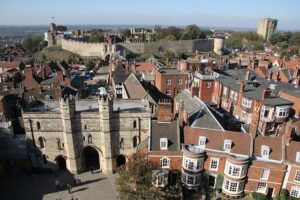Lincoln Castle
Jump to
Recommended Pages
Lincoln Castle is a major Norman castle in Lincoln, East Mercia. The castle was constructed by Willem the Conqueror around AD 1068, following his seizure of the English throne. Originally home to the Earls of Chester, it was later part of the Marcdom of Nottingham and is now fully submerged following sea level rise during the Great Torrent of 781.
Early History
During the First Hycath War, the castle was the major battleground for the armies of King Stephen and Empress Matilda “Maud” Beauclerc. Captured by King David I of Scotland, the surrounding lands belonging to Ranulf De Gernon and his adoptive mother Lucy of Bolingbroke, were subsequently gifted to King David by King Stephen. As a result, Ranulf swore allegiance to Maud, and reclaimed the castle using a cunning plan in which he and his half-brother William de Roumare snuck into the castle disguised as peasants before throwing open the gates and admitting their forces.
In AD 1141/YE 1, King Stephen responded to claims of unrest in Lincoln by initiating The Siege of Lincoln Castle to reclaim its territory from Empress Maud’s control. Ranulf was quickly supported by the Empress herself as well as the army of her half-brother, Robert of Gloucester. The combined forces of Maud, Ranulf, and Robert’s armies faced off against King Stephen and his armies over the castle at the Battle of Lincoln, in AD 1141/YE 1. Maud’s army benefitted hugely from her powerful Hycathic magic and was able to bombard Stephen’s armies. This resulted in King Stephen’s defeat and eventual death, thus ending the First Hycath War.
After the War
At the end of the First Hycath War, Lincoln Castle reverted to the ownership of the Crown and was gifted by Empress Matilda to Gabriella Fitzwalter, first Margrave of Nottingham, in recognition of her assistance during the war.
It remained in the Fitzwalter family for over 500 years, acquiring extensive landscaped gardens in the 7th century YE and a new west wing extension in YE 732. Submerged following the Great Torrent of YE 781, most of its valuable artefacts were able to be retrieved and can now be viewed as part of the Museum of Nottingham’s permanent collection.


